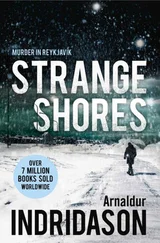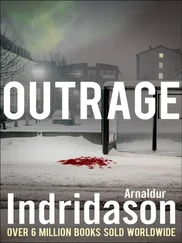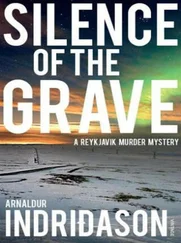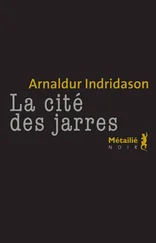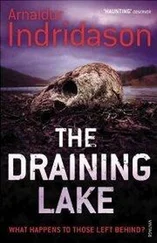It sat flush with the wall and Erlendur hadn’t noticed it until he’d started his tapping. The door was no more than a metre high and had a small keyhole but no frame. It was locked and Erlendur, who had nothing on him but a car key, tried his best to force it open, without success. He cast around for the key, then went downstairs to the kitchen again, turned on the light and started pulling out drawers in search of some implement to open the door with. In one drawer he unearthed three keys of varying sizes and dates, and took these up to the bedroom. The smallest key fitted the door under the eaves.
Erlendur lit a match and shone it into the cavity which was small, narrow and cold. There was nothing inside. He assumed the occupants of the house had used it to store the usual kinds of belongings that weren’t required every day. The match burnt out and, lighting another, he shone it over the floor and up under the roof. In his heedlessness, he held the flame too long against the ceiling lining and singed it. Startled, he extinguished the match and ran a hand over the surface, terrified that he had set fire to it. As he fumbled in the dark, his fingers brushed against something that was poking out of the lining; it felt like a piece of paper.
Erlendur lit a third match and shone it up under the ceiling, carefully this time. He saw that he had burnt a small hole in the lining. He thanked his lucky stars that he hadn’t been stupid enough to set the house on fire with his tampering. Through the hole, which was no larger than a coin, he glimpsed the roof timbers but when he illuminated the surrounding area better he spotted a split in the lining. That was where his fingertips had brushed against some unevenness; something that had been pushed into the crack for concealment and remained there ever since.
With great difficulty he managed to extract it from behind the lining paper: a few folded notes or sheets of paper. Having made sure there was nothing else in this odd little space under the eaves, he moved over to the dormer window to peer at what he had in his hands. There wasn’t enough light, so he went into the bedroom that faced the street. It was slightly less dark in there and he could get a better idea of his discovery.
What he had in his hands turned out to be a few lined pages of diary size. The handwriting was for the most part pretty and neat, but in places it degenerated into a scrawl. On one page the name ‘Dagbjört’ had been copied out repeatedly in the margins, as if she had been practising her signature. The pages were like a message in a bottle from the past, a message which Dagbjört had not intended anyone to read yet couldn’t quite bring herself to throw away. Some of the entries were dated, others not. Erlendur saw how her writing had matured from the first notes to what appeared to be the last. Several years had passed in the interim and they showed a young girl growing up. The oldest contained a declaration of love from when she was in the final year of junior school. She had a crush on a boy called Tommi and had decorated his name with small red hearts. Another page revealed she had been angry that day with an unnamed girl in her class. The last note consisted of only a few sentences, scribbled down the day she celebrated her eighteenth birthday.
It’s so horribly creepy. I don’t know if I can even tell Daddy and Mummy. He seems so harmless. And he’s our neighbour. He thinks I can’t see him. He stands in his window in the dark, staring at me while I’m getting ready for bed. When I turn off the lights and peer out, I can see him lurking in the shadows. God, it’s so bizarre. What’s he doing? Why does he stare in at me like that?
Erlendur read the girl’s words again before finally raising his eyes from the pages, his mind filled with the silence of the house, the cruelty of fate, ignorance and oblivion.
On the way back to town Marion stopped off at the old sanatorium, having meant to go there for a while but never finding the time or the right occasion. Now that occasion had arrived out of the blue, postmarked Denmark. Over the years, the urge to visit the sanatorium had become more and more infrequent and it was a long time since Marion had last walked up the hill to Gunnhildur’s Cairn. If patients made it up here in the old days it was a sign they were on the road to recovery. Marion had been admitted to Vífilsstadir, the TB sanatorium, as a child, with only one working lung, and had watched as other children the same age died.
The pavilion where the patients used to lie and recuperate in the fresh air still stood to the west of the main building but was dilapidated from years of disuse and neglect. After parking near the pavilion, Marion lingered briefly among the broken windows and flaking paint. The lights from the hospital cast a faint glow over the surroundings down as far as the lake. Now that TB had been eradicated, the hospital treated patients for other types of respiratory disorder.
Standing in the run-down pavilion, feeling the cold, Marion recalled the visitors who used to come at weekends and talk to their loved ones through the windows of the hospital because they weren’t allowed inside. Many of Marion’s most painful memories were associated with this place, and also with a spell at the Kolding Sanatorium in Denmark, arranged by Marion’s grandmother, which had eventually led to recovery. There had been another Icelander there, a girl called Katrín, who had survived a severe case of pulmonary tuberculosis thanks to a procedure known as thoracoplasty, which involved sacrificing several ribs on one side so the infected lung could be collapsed and cleaned out. Their friendship had developed over the years into a kind of love affair, though Katrín had lived abroad for the most part, working for charity organisations around the world.
The letter from her mother, which had arrived that morning, was in Marion’s pocket, read, reread and read again until the words were etched into the memory. Katrín’s mother wrote that her daughter was dead. She had been diagnosed with cancer the year she sailed out to Iceland and ended her relationship with Marion. At the time she had only expected to live another twelve months at most. But in the event she had lasted another seven years. According to her wishes she had been cremated and her ashes scattered in Kolding Fjord.
Marion took the letter out now and read it one more time by the faint illumination from the hospital, and thought about Erlendur and his fascination with people who met sudden deaths in accidents, perished from exposure or were lost in the mountains. Once, finding him immersed in this sort of account, Marion had tried to understand what was going through his mind. The young policeman was a frequent source of curiosity to Marion since he seemed so independent in his thinking, was old-fashioned in his manner, never spoke about himself, disliked city life, and took little interest in the times he lived in except when they got on his nerves. He was single-minded, felt no need whatsoever to wear his heart on his sleeve and was perpetually absorbed by this peculiar fixation with ordeals and disappearances.
‘What is it about people’s suffering and death that you find so gripping?’ Marion had asked.
‘You can learn a lot about people from these stories,’ Erlendur had replied.
‘Who all just happen to have lost their lives in unusual circumstances?’
‘You could put it like that.’
‘But what’s so instructive about that? About people getting lost? Dying? What is it you learn from that?’
Erlendur clearly found this hard to answer.
‘Why are you asking?’ he said at last.
‘Because I’d like to know,’ said Marion. ‘You’re the only person I’ve ever met who’s obsessed with this subject.’
Читать дальше

